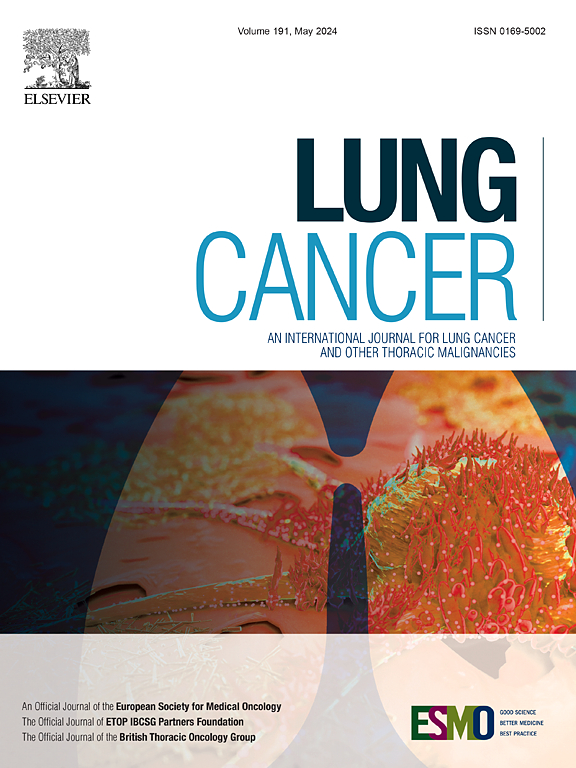Characterization and economic burden of KRASG12C-mutant lung cancer in real-world Spanish practice: a retrospective observational study (SILK study)
IF 4.4
2区 医学
Q1 ONCOLOGY
引用次数: 0
Abstract
Introduction
Real-world evidence on the direct healthcare costs of patients with KRASG12C-mutant non-small-cell lung cancer (NSCLC) is limited.
Material and Methods
Multicenter, observational, retrospective study in patients newly diagnosed with advanced-stage NSCLC harboring the KRASG12C mutation within real-world clinical practice in Spain. Patient characteristics, treatment patterns, outcomes, and direct healthcare costs were collected from medical records and administrative databases between January 1, 2016, and March 9, 2022.
Results
127 patients were included in the study, with global and disease-related economic data available for 125 and 104 patients, respectively. Most patients (97.6%) were current or former smokers. The most prevalent co-mutations or genetic alterations at baseline involved TP53 (38.2%), ATM (20.0%), and STK11 (15.4%) genes. 94 patients (74.0%) received systemic therapy. Chemotherapy was the most common first-line (63.8%) and immunotherapy the most common second-line therapy (64.6%). Median progression-free survival (95% CI) for the first, second and third treatment lines was 4.6 (2.8–7.8), 3.8 (1.5–8.2), and 2.2 (0.1–9.9) months, respectively. Median overall survival (95% CI) was 7.7 (4.9–11.0), 9.0 (3.0–14.3), and 8.9 (0.1–19.7) months, respectively. Total global cost over the study period amounted to €5,706,820 (€46,023 per patient), with pharmacological costs totaling €2,353,299 (€18,978 per patient). Disease-related costs were €4,219,410 (€40,965 per patient), with disease-related pharmacological costs of €2,157,627 (€20,948 per patient).
Conclusion
These real-world data highlight the limited outcomes for most NSCLC patients with KRASG12C mutations, underscoring the significant clinical and economic burden associated with their care. The evaluation of the impact of novel and effective targeted therapies is therefore warranted.
krasg12c突变肺癌的特征和经济负担:一项回顾性观察性研究(SILK研究)
关于krasg12c突变的非小细胞肺癌(NSCLC)患者的直接医疗费用的真实证据是有限的。材料和方法在西班牙临床实践中对新诊断的晚期非小细胞肺癌患者进行多中心、观察性、回顾性研究,这些患者携带KRASG12C突变。从2016年1月1日至2022年3月9日期间的医疗记录和管理数据库中收集患者特征、治疗模式、结果和直接医疗保健费用。127例患者纳入研究,分别有125例和104例患者的全球和疾病相关经济数据。大多数患者(97.6%)是当前或曾经的吸烟者。基线时最常见的共突变或基因改变涉及TP53(38.2%)、ATM(20.0%)和STK11(15.4%)基因。94例(74.0%)患者接受了全身治疗。化疗是最常见的一线治疗(63.8%),免疫治疗是最常见的二线治疗(64.6%)。第一、第二和第三治疗线的中位无进展生存期(95% CI)分别为4.6(2.8-7.8)、3.8(1.5-8.2)和2.2(0.1-9.9)个月。中位总生存期(95% CI)分别为7.7(4.9-11.0)、9.0(3.0-14.3)和8.9(0.1-19.7)个月。研究期间的全球总成本为5,706,820欧元(每位患者46,023欧元),药理学成本总计2,353,299欧元(每位患者18,978欧元)。疾病相关费用为4,219,410欧元(每名患者40,965欧元),疾病相关药理学费用为2,157,627欧元(每名患者20,948欧元)。这些真实数据强调了大多数KRASG12C突变的NSCLC患者的有限结果,强调了与他们的护理相关的重大临床和经济负担。因此,对新颖有效的靶向治疗的影响进行评估是必要的。
本文章由计算机程序翻译,如有差异,请以英文原文为准。
求助全文
约1分钟内获得全文
求助全文
来源期刊

Lung Cancer
医学-呼吸系统
CiteScore
9.40
自引率
3.80%
发文量
407
审稿时长
25 days
期刊介绍:
Lung Cancer is an international publication covering the clinical, translational and basic science of malignancies of the lung and chest region.Original research articles, early reports, review articles, editorials and correspondence covering the prevention, epidemiology and etiology, basic biology, pathology, clinical assessment, surgery, chemotherapy, radiotherapy, combined treatment modalities, other treatment modalities and outcomes of lung cancer are welcome.
 求助内容:
求助内容: 应助结果提醒方式:
应助结果提醒方式:


